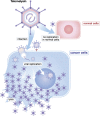Gene therapy for cancer: present status and future perspective
- PMID: 26056594
- PMCID: PMC4452068
- DOI: 10.1186/2052-8426-2-27
Gene therapy for cancer: present status and future perspective
Abstract
Advancements in human genomics over the last two decades have shown that cancer is mediated by somatic aberration in the host genome. This discovery has incited enthusiasm among cancer researchers; many now use therapeutic approaches in genetic manipulation to improve cancer regression and find a potential cure for the disease. Such gene therapy includes transferring genetic material into a host cell through viral (or bacterial) and non-viral vectors, immunomodulation of tumor cells or the host immune system, and manipulation of the tumor microenvironment, to reduce tumor vasculature or to increase tumor antigenicity for better recognition by the host immune system. Overall, modest success has been achieved with relatively minimal side effects. Previous approaches to cancer treatment, such as retrovirus integration into the host genome with the risk of mutagenesis and second malignancies, immunogenicity against the virus and/or tumor, and resistance to treatment with disease relapse, have markedly decreased with the new generation of viral and non-viral vectors. Several tumor-specific antibodies and genetically modified immune cells and vaccines have been developed, yet few are presently commercially available, while many others are still ongoing in clinical trials. It is anticipated that gene therapy will play an important role in future cancer therapy as part of a multimodality treatment, in combination with, or following other forms of cancer therapy, such as surgery, radiation and chemotherapy. The type and mode of gene therapy will be determined based on an individual's genomic constituents, as well as his or her tumor specifics, genetics, and host immune status, to design a multimodality treatment that is unique to each individual's specific needs.
Keywords: Adenoviruses; Clinical trials; Electroporation; Gene silencing; Gene transfer technique; Immunomodulation; Molecular targeted therapy; Oncolytic viruses; Retroviruses; Suicide transgenes.
Figures




References
-
- Lander ES, Linton LM, Birren B, Nusbaum C, Zody MC, Baldwin J, Devon K, Dewar K, Doyle M, FitzHugh W, Funke R, Gage D, Harris K, Heaford A, Howland J, Kann L, Lehoczky J, LeVine R, McEwan P, McKernan K, Meldrim J, Mesirov JP, Miranda C, Morris W, Naylor J, Raymond C, Rosetti M, Santos R, Sheridan A, Sougnez C, et al. Initial sequencing and analysis of the human genome. Nature. 2001;409(6822):860–921. doi: 10.1038/35057062. - DOI - PubMed
-
- Venter JC, Adams MD, Myers EW, Li PW, Mural RJ, Sutton GG, Smith HO, Yandell M, Evans CA, Holt RA, Gocayne JD, Amanatides P, Ballew RM, Huson DH, Wortman JR, Zhang Q, Kodira CD, Zheng XH, Chen L, Skupski M, Subramanian G, Thomas PD, Zhang J, Gabor Miklos GL, Nelson C, Broder S, Clark AG, Nadeau J, McKusick VA, Zinder N, et al. The sequence of the human genome. Science (New York, NY) 2001;291(5507):1304–1351. doi: 10.1126/science.1058040. - DOI - PubMed
-
- Strachan T, Read A. Gene therapy and other molecular genetic-based therapeutic approaches. In: Strachan T, Read AP, editors. Human Molecular Genetics. 2. New York: Wiley-Liss; 1999.
Publication types
LinkOut - more resources
Full Text Sources
Other Literature Sources
